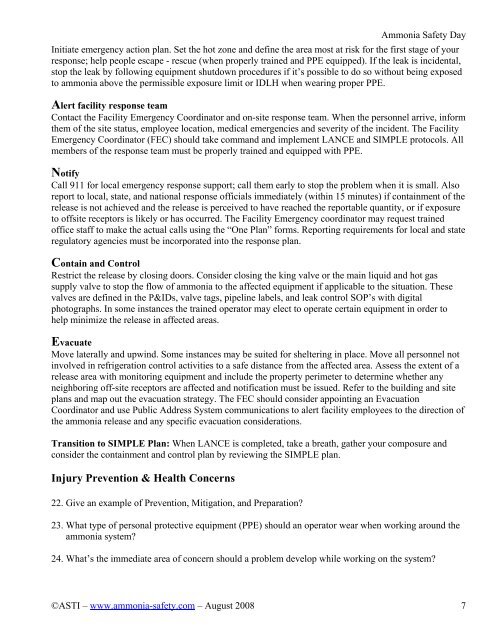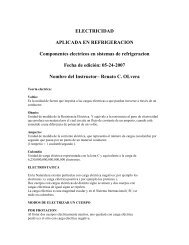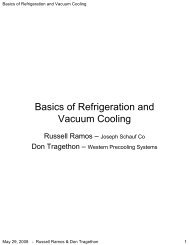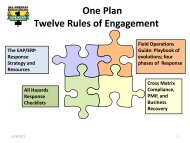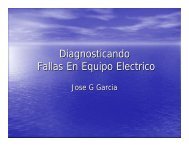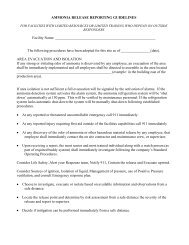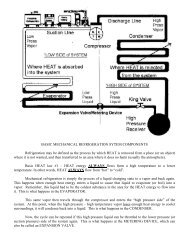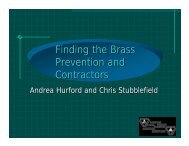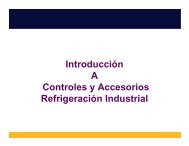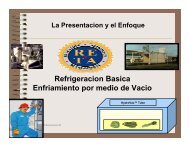Awareness Training Goals - Salinas Valley Ammonia Safety Day
Awareness Training Goals - Salinas Valley Ammonia Safety Day
Awareness Training Goals - Salinas Valley Ammonia Safety Day
You also want an ePaper? Increase the reach of your titles
YUMPU automatically turns print PDFs into web optimized ePapers that Google loves.
<strong>Ammonia</strong> <strong>Safety</strong> <strong>Day</strong><br />
Initiate emergency action plan. Set the hot zone and define the area most at risk for the first stage of your<br />
response; help people escape - rescue (when properly trained and PPE equipped). If the leak is incidental,<br />
stop the leak by following equipment shutdown procedures if it’s possible to do so without being exposed<br />
to ammonia above the permissible exposure limit or IDLH when wearing proper PPE.<br />
Alert facility response team<br />
Contact the Facility Emergency Coordinator and on-site response team. When the personnel arrive, inform<br />
them of the site status, employee location, medical emergencies and severity of the incident. The Facility<br />
Emergency Coordinator (FEC) should take command and implement LANCE and SIMPLE protocols. All<br />
members of the response team must be properly trained and equipped with PPE.<br />
Notify<br />
Call 911 for local emergency response support; call them early to stop the problem when it is small. Also<br />
report to local, state, and national response officials immediately (within 15 minutes) if containment of the<br />
release is not achieved and the release is perceived to have reached the reportable quantity, or if exposure<br />
to offsite receptors is likely or has occurred. The Facility Emergency coordinator may request trained<br />
office staff to make the actual calls using the “One Plan” forms. Reporting requirements for local and state<br />
regulatory agencies must be incorporated into the response plan.<br />
Contain and Control<br />
Restrict the release by closing doors. Consider closing the king valve or the main liquid and hot gas<br />
supply valve to stop the flow of ammonia to the affected equipment if applicable to the situation. These<br />
valves are defined in the P&IDs, valve tags, pipeline labels, and leak control SOP’s with digital<br />
photographs. In some instances the trained operator may elect to operate certain equipment in order to<br />
help minimize the release in affected areas.<br />
Evacuate<br />
Move laterally and upwind. Some instances may be suited for sheltering in place. Move all personnel not<br />
involved in refrigeration control activities to a safe distance from the affected area. Assess the extent of a<br />
release area with monitoring equipment and include the property perimeter to determine whether any<br />
neighboring off-site receptors are affected and notification must be issued. Refer to the building and site<br />
plans and map out the evacuation strategy. The FEC should consider appointing an Evacuation<br />
Coordinator and use Public Address System communications to alert facility employees to the direction of<br />
the ammonia release and any specific evacuation considerations.<br />
Transition to SIMPLE Plan: When LANCE is completed, take a breath, gather your composure and<br />
consider the containment and control plan by reviewing the SIMPLE plan.<br />
Injury Prevention & Health Concerns<br />
22. Give an example of Prevention, Mitigation, and Preparation?<br />
23. What type of personal protective equipment (PPE) should an operator wear when working around the<br />
ammonia system?<br />
24. What’s the immediate area of concern should a problem develop while working on the system?<br />
©ASTI – www.ammonia-safety.com – August 2008 7


